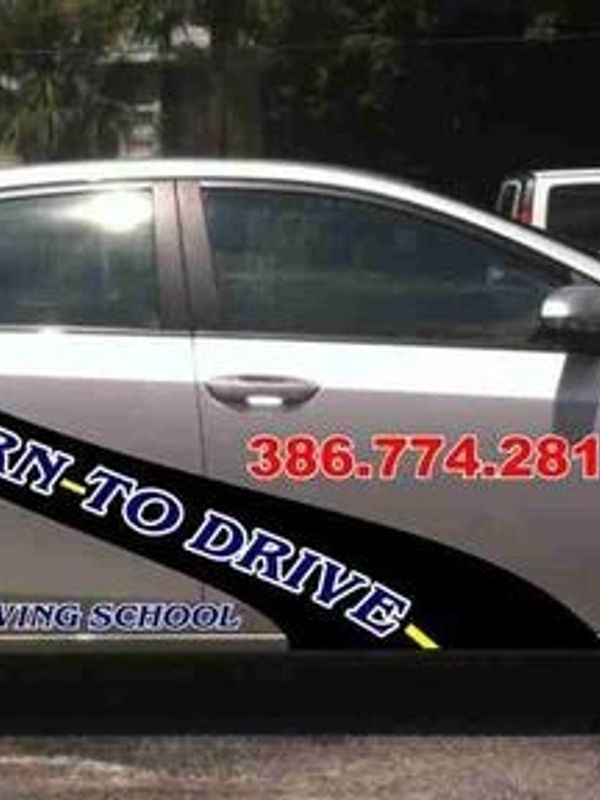Drive for Yourself & the Rest!

Never make a lane change without looking and checking the blind spot; mirrors won't give you the blind spot. The only way you can see a car next to you on your blind spot is when you turn your head over your shoulder, either left or right.
A Learn to Drive specializes in developing the student's confidence for them to feel and be safe on the road; instructors won't stop practicing until you yourself understand that you know how to execute a maneuver. Running commentaries is another thing we work with you on; you will be pointing out SITUATION on the road that you observe in others drivers, and we will be talking about that subject. A Learn to drive wants to see safe drivers on the road, and that is our commitment with you; the better we teach you, the better drivers on the road. You have to remember that when you get behind the wheel, you have to drive for yourself and for the rest of the people on the road. After your training is completed, A Learn to drive will take you to the DMV for your driving test to get your license. 'IT'S A GREAT PLEASURE TO SAY THAT a Learn to drive HAS A GREAT PERCENTAGE OF STUDENTS PASSING THE TEST THE FIRST TIME.
TO THE PARENTS ALSO GO IN SMALL PARAGRAPH, AND THE REST READ MORE…….

TO THE PARENTS
Get involved with your teen; remember that teens in Florida need 50 hours of driving, and 10 of those have to be night driving. Choose a driving school with a good reputation, experience, and aptitude, willing to take the time to teach your teen depending on their needs. Ask friends where their kids learn how to drive and if they were able to pass the road test the first time. Ask a question about the driving instructor, how professional they look, and if the instructor was polite and patient. When driving with your teen, try to obey the rules of the road, too; remember they spend more time with you than with the driving school, so don't forget that they may want to emulate your driving behavior and techniques.
Learning to drive is an exciting time for teen and their parents. Driving is something that has to be taken seriously. Car crashes are the number one cause of death, not just for teens but also for all people.
As a parent, you have a big role in your teen driving habits.
They emulate and copy what we do. Be a role model, and don't allow your teen to do the following.
Did you know that over 33% of new teen drivers are in a crash their first year, and 4 out of 5 teen crashes

INCREASE YOUR ABILITIES
HERE THE SAME THING SMALL PARAGRAPH AND THEN READ MORE………
Driving in Rain and Fog
Wet roads and or fog add to the complexity of driving.
- Driving too fast for the conditions and obscures vision due to weather or other issues are the #2 and #10 factors, respectively, in fatal crashes,
- hydroplaning (where water between the roadway and your tires adversely affects your ability to drive or steer) can occur at speeds as low as 30 mph.
Practice driving in such conditions, if done properly, can improve a student's depth of experience and make them safer drivers, don't forget that we are in Florida, and you can expect rain any time.
We suggest all drivers do the following in adverse weather conditions:
- Reduce your speed- don't forget that speed limits are set for ideal conditions
- Increase your following distance from the normal 3 seconds from the vehicle in front of you to 5 seconds or more.
- Brake smoothly, evenly, and easily don't wait too late to stop
- Try to avoid standing water; if safe to do so, change lanes
- Use your low beams to make yourself more visible, day and night; we encourage you to have your teen practice driving in such conditions but only when you feel it is safe and they are prepared to do so.
THIS ONE ALSO GOES ON A LITTLE PARAGRAPH AND THEN SEE MORE…….

DISTRACTED DRIVERS
Things to know.
- 16% of fatal crashes involve driver distraction anything that takes your focus off the road
- Teens are the #1 age group for crashes due to driver distraction
- People who text while driving are 23 times more likely to be in a crash
- Talking on a cell phone reduces the amount of brain activity associated with driving by 37%, and 19% of all drivers and 37% of 18-27-year-old drivers regularly send texts while driving. Cell phones and texting are the main reason why so many accidents.
Do you, as a parent, what is the best thing to do?
- Be a good sample for your teens. Doesn't use the cell phone when driving; remember that kids copy what parents do.
- Turn your cell phone off
- Talk to your kids about the use of cell phone texting and all distractions before they start driving. Same as the use of alcohol Cell phone "Zero tolerance" simple as that.

DISTRACTED DRIVING
1. What is distracted driving?
There are three main types of distraction:
- Visual - taking your eyes off the road
- Manual - taking your hands off the wheel
- Cognitive - taking your mind off what you're doing
Distracted driving is any non-driving activity a person engages in while operating a motor vehicle. Such activities have the potential to distract the person from the primary task of driving and increase the risk of crashing.
2. Why do people do it?
There are many reasons for distracted driving, including busy lifestyles, stressful jobs, and the presence of children and pets in the car. Many people use technology such as cell phones, Blackberries, and other electronic devices as their main means of communication. They forget to put these devices down when they should be paying the closest attention to their driving for the sake of their own safety and that of others.
3. Who are the offenders, and how great a problem isthis?
Everyone is guilty to a certain extent. The youngest Americans are most at risk, but they are not alone.
This website uses cookies.
We use cookies to analyze website traffic and optimize your website experience. By accepting our use of cookies, your data will be aggregated with all other user data.